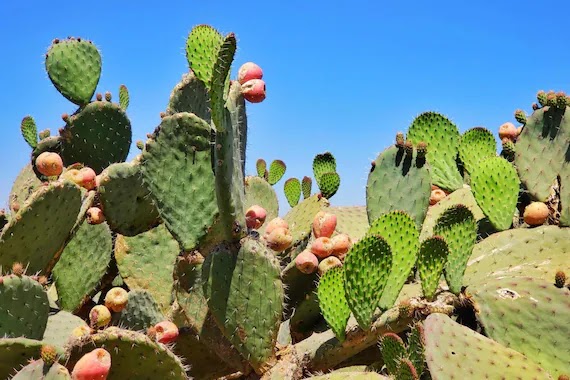A Nutritious and Sustainable Source
Edible cacti have gained popularity not only for their nutritional benefits, but also for their adaptability and role in food sustainability. In this article, we will explore in depth the species of cacti that are used in gastronomy, their nutritional values, and the various ways they can be incorporated into the diet.
Edible cacti are an essential part of the diet in many cultures, especially in arid regions where these plants thrive. The prickly pear cactus (Opuntia ficus-indica) is one of the best known and is widely consumed in Mexico and other countries. In addition to being delicious, these cacti offer a wide range of health and environmental benefits.
Nutritional Benefits of Edible Cacti
Eating edible cacti is an excellent way to obtain essential nutrients. Among its main nutritional benefits are:
• Rich in fiber: Cacti, especially the prickly pear cactus, contain high levels of fiber, which helps improve digestion and prevent constipation.
• Low in calories: Ideal for those looking to lose weight or maintain a balanced diet.
• Source of antioxidants: The compounds present in cacti help fight free radicals and reduce the risk of chronic diseases.
• Vitamins and minerals: They contain vitamin C, vitamin A, magnesium and calcium, essential for the proper functioning of the body.
Culinary Uses of Cacti
Edible cacti are extremely versatile in the kitchen. Here are some of the most common ways to prepare them:
• Salads: Fresh nopal can be cut into strips and combined with tomatoes, onions and avocado for a refreshing salad.
• Stews: Nopales are often cooked with meats, chili peppers and spices to create traditional dishes such as nopal con chile colorado.
• Tortillas and tacos: In Mexico, nopales are roasted and served as a taco filling or as a side dish.
• Juices and smoothies: Nopal juices are popular for their detoxifying properties and their ability to regulate blood glucose levels.
• Sweets and jams: The fruit of the cactus, known as prickly pear, is used to prepare natural sweets and jams.
Medicinal Properties of Edible Cacti
The use of cacti in traditional medicine has been widely documented. Some of its main benefits include:
• Diabetes control: The prickly pear helps reduce blood sugar levels, making it ideal for people with type 2 diabetes.
• Anti-inflammatory properties: Consuming cacti can help reduce inflammation in the body.
• Improved intestinal health: The fiber present in edible cacti promotes a healthy intestinal microbiome.
Sustainability and Edible Cacti
Cacti are not only beneficial for health, but also for the environment. These plants are a sustainable solution to address problems such as water scarcity and desertification. Among their environmental benefits are:
• Low water consumption: Cacti require very little water to grow, making them ideal for arid regions.
• Reduction of erosion: The roots of cacti stabilize the soil, preventing erosion.
• Livestock Feed: Prickly pear cactus is used as livestock feed during times of drought.
Edible Cacti in the Food Industry
The use of cacti in the food industry is growing rapidly. Some applications include:
• Flours: Prickly pear cactus flour is used to make low-carb breads and baked goods.
• Food Supplements: Cactus extracts are marketed as supplements due to their antioxidant and anti-inflammatory properties.
• Beverages: Prickly pear and tuna-based beverages are becoming increasingly popular.
How to Grow Edible Cacti
Growing your own edible cacti is an economical and sustainable way to enjoy their benefits. Here are some tips:
1. Choose the right species: Make sure you select edible varieties like prickly pear cactus.
2. Plant in well-drained soil: Cacti need soil that doesn't retain too much moisture.
3. Provide enough sunlight: Cacti require at least 6 hours of sunlight a day.
4. Moderate watering: Although they need water, it is important not to overwater to avoid rot.
Recipes with Edible Cactus
Below, we share some simple and delicious recipes:
• Nopal salad: Mix cooked nopales with tomato, onion and cilantro. Season with lemon and salt.
• Nopal tacos: Grill the nopales and serve with tortillas, beans and salsa.
• Green nopal juice: Blend nopales with pineapple, orange and water for a refreshing drink.
Conclusion
Edible cacti are a wonder of nature that combines health benefits, environmental sustainability and culinary versatility. Incorporating them into your diet will not only enrich your menu, but will also contribute to a healthier and more environmentally conscious lifestyle. Discover the flavors and benefits of edible cacti and transform your diet!






